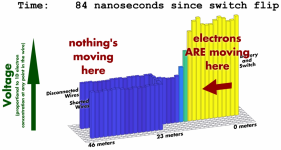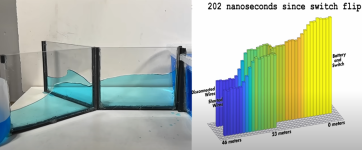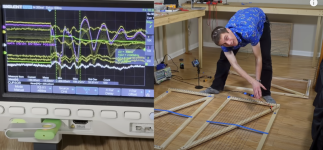Yes electrons are the charge carriers. They have no force until they are placed in an electromagnetic field. In AC they sit there and vibrate they don't travel 1 meter per hour. The smoothness of the surface of the copper wire doesn't matter because the electromagnetic field exists along the wire and it's relatively huge.It’s the moving electrons (charged particles) in the conductor that produce current. Current is a calculated quantity and a scalar quantity. Neither electrons or current is an electromagnetic field. Having said that, there are electric fields involved, but they lie outside the conductor, they are the induced e and b fields. Induced by the current and voltage. The drift electrons, the ones I’m referring to, travel inside the conductor at very slow speed 1 m/hour back and forth in the conductor in AC circuit alternating direction according to the instantaneous audio frequency. Get thee to a library pronto!!
@geoffkait
@Arthur Jackson
I found your comments worthy of further investigation and it seems that in the following link there is the case.
From "U.S. Energy Information Administration" website:
Electricity explained - The science of electricity
@Arthur Jackson
I found your comments worthy of further investigation and it seems that in the following link there is the case.
From "U.S. Energy Information Administration" website:
Electricity explained - The science of electricity
Unless we've been conditioned to believe that...“What we believe is largely the result of conditioning.”
Where are you Phillip Dick? We need you more than ever...
Out come the knives, I thought we were better than to use personal attacks, I’m just trying to have a conversation. What’s up with all the drama?
Yes electrons are the charge carriers. They have no force until they are placed in an electromagnetic field. In AC they sit there and vibrate they don't travel 1 meter per hour. The smoothness of the surface of the copper wire doesn't matter because the electromagnetic field exists along the wire and it's relatively huge.
I suspect you need to brush up a little bit on your information, maybe a nice trip to your local lib. Drift electrons which are the ones we’re talking about move very slowly as I said, one meter per hour. You have apparently convinced yourself of a logical fallacy. As I also already pointed out the importance of the electrons is the charge not the force, and it’s the electron motion that causes the speaker diaphragm to move back and forth. It’s because the moving electrons produced a magnetic field. I bet you think the force of the electrons is what makes the speaker diaphragm move IN and OUT. That’s very amusing.
Last edited:
If you don’t care - which is no skin off my nose - why are you even here? Of course fuse wire directionality implies that all wire is directional. Hel-loo! In for a penny in for a pound. I hereby dub this thread the Rip Van Winkle thread.Because I don't care about Schumann Resonance... or any of those other things. If you'd like to discuss it with him, be my guest.
I am curious about his claim that was made in almost absolute terms that people (at least some) can hear when cables / wires / fuses are reversed and that the basis for this seems to have possibly started with an advertisement for fuses. I simply would like to know if that's the only evidence that went into supporting what I'd consider an outlandish claim, or if there is something I've clearly missed in my cursory research. Geoff doesn't strike me as the kind of person that would read that 'data sheet' and jump to the conclusion that all wires in a system should be oriented one way or another for best performance. If he did, no worries.
Last edited:
^ So you have no further evidence.
Let me help you with some basic logic -
Let me help you with some basic logic -
- An implication does not a fact make.
- Even if the wire were directional and that were stipulated, that doesn't remotely imply that any human could hear the difference when a fuse (or any other wire for that matter) is "reversed".
- Stringing together faulty logic and trying to convince me that you have some basis in fact has gone nowhere. I was sincerely giving you the benefit of the doubt to provide even one decent shred of credible information that your outlandish claim holds any water.
No that's not what I think. I think you need to go to the library and read up on alternating current.I suspect you need to brush up a little bit on your information, maybe a nice trip to your local lib. Drift electrons which are the ones we’re talking about move very slowly as I said, one meter per hour. You have apparently convinced yourself of a logical fallacy. As I also already pointed out the importance of the electrons is the charge not the force, and it’s the electron motion that causes the speaker diaphragm to move back and forth. It’s because the moving electrons produced a magnetic field. I bet you think the force of the electrons is what makes the speaker diaphragm move IN and OUT. That’s very amusing.
 @geoffkait You are on very thin ground. Rein in the misinformation or find yourself in read only mode.
@geoffkait You are on very thin ground. Rein in the misinformation or find yourself in read only mode.Particle flow naturally isn't proportional to wave propagation. Similarly, the speed of sound remains fixed regardless of frequency or intensity.
In this video a scope array is spread along lengths of wire to show wave propagation as it settles, and is compared to electron motion, and against differing termination. In a style a DIYer may appreciate it fits measured data to a propagation model.





In this video a scope array is spread along lengths of wire to show wave propagation as it settles, and is compared to electron motion, and against differing termination. In a style a DIYer may appreciate it fits measured data to a propagation model.





Bi-wiring for very low output impedance amplifier might be beneficial as stated by Bruno Putzeys.
The distortion current from one driver is now sank to the amplifier instead of feeding to another driver.
I guess that's also why mola mola amplifiers have biwire connectors.
The distortion current from one driver is now sank to the amplifier instead of feeding to another driver.
I guess that's also why mola mola amplifiers have biwire connectors.
I have never interpreted the term "bi-wiring" to mean anything less than running each driver on a separate amp channel, and with each crossover band being wired independently within the speaker.
If all you do is run a separate cable from the speaker terminals to the same terminals on the amp, you're achieving nothing other than effectively increasing the gauge of the wire going to your speakers. I too can not see much benefit in this unless you were using wires that were too thin to begin with.
If all you do is run a separate cable from the speaker terminals to the same terminals on the amp, you're achieving nothing other than effectively increasing the gauge of the wire going to your speakers. I too can not see much benefit in this unless you were using wires that were too thin to begin with.
"Of course I hear a difference! I use the finest CAT5 for my speakers, one twisted pair for the low end, another for the highs..."
Who am I to argue?
I posted this link recently and the only response I got was some sort of put-down insult. Here goes again.
https://www.susanblackmore.uk/chapters/why-i-have-given-up/
ETA: Okay, I'm a glutton for punishment, I also post that link as a comment in the video.
I have come across a person or two who used telephone wire or ethernet cable to run to tweeters. One buddy I knew back in another state would strip cat5 cable outer insulation, unwind all the wires, and then braid them together to make a cable. He swore by them. I gave them a listen and maaaaybe did hear a difference on the highs but it seemed like a whole lot of trouble for a very small gain.
Maybe he's on to something, because I have seen speaker cables that are constructed with complicated braiding patterns. I guess this was the poor-man's way of making something expensive out of something cheap.
I use multistrand high purity copper and don't worry about anything else except with interconnects since their signals are so much more delicate than what goes to the speakers.
Bi-wiring for very low output impedance amplifier might be beneficial as stated by Bruno Putzeys.
The distortion current from one driver is now sank to the amplifier instead of feeding to another driver.
I guess that's also why mola mola amplifiers have biwire connectors.
I suppose this would indeed happen if the impedance of having to travel the path from speaker to amp and back to speaker might be increased as compared to jumping straight across the speaker terminals.
But as I've said before, I always thought "bi-wiring" was giving each driver its own amp channel, but I suppose to be more accurate and specific this would mean "bi-amping." I guess I made that assumption because I can't see a benefit to "bi-wiring" as it is more specifically defined.
Precisely. In my quite long experience, I have discovered many times over that as soon as listening tests are unsighted, Golden Ears immediately become Cloth Ears; Ivor Tiefenbrun being probably the highest profile example. Further, I find it more than a little odd that any person in the scientific sphere would ever even consider using the word 'belief'. We know fulwell that anyone can believe in anything, making it an utterly useless path to truth.Where's the evidence?
Simple belief, and expectation bias in home audio seems to exist like in no other sphere of fundamentally scientific pursuit of improvement I have come across, which I find terribly sad, and a massive limitation to actual development and improvements of sound reproduction. Thankfully it is far less prevalent in the PA world, where original design and continual product development yields worthwhile improvements.
Last edited:
Yet some differences are plainly audible, sighted or not. There are two files at Purifi that measure exactly the same on an FFT spectrum analyzer, yet sound different (on headphones).
https://purifi-audio.com/blog/tech-notes-1/doppler-distortion-vs-imd-7
https://purifi-audio.com/blog/tech-notes-1/doppler-distortion-vs-imd-7
I don't know that we use the same definition of belief, but overall I agree.I find it more than a little odd that any person in the scientific sphere would ever even consider using the word 'belief'. We know fulwell that anyone can believe in anything, making it an utterly useless path to truth.
In my context - I use this - "an acceptance that a statement is true or that something exists."
Even in the scientific sphere, one can use facts, faith, or a little bit of both to come to believe something. Me, I lean toward evidence through experimental study, but I don't begrudge those that lean more toward faith or trust in others' 'word'. No skin off my nose, I was sincerely curious how one can come to believe that turning a fuse around would have an audible effect, reliably and repeatably.
I also should probably reiterate more plainly what should come as an obvious statement, and why I was doing my best to be courteous to another member. Just because something doesn't happen reliably and repeatably over randomness, doesn't mean it never happens. It's not that I don't believe that no one person ever heard whatever when whatever was changed ... it's that I have never seen sufficient evidence for ME to believe that it would occur reliably and repeatably over a random event or some other special cause variation. Others can choose (and likely should) choose to have different thresholds for choosing to accept something as "true".
Cheers!
- Status
- Not open for further replies.
- Home
- Loudspeakers
- Multi-Way
- Bi-wiring and the placebo effect - interesting video